-
Car Reviews
- All reviews
- Midsize SUVs
- Small cars
- Utes
- Small SUVs
- Large SUVs
- Large cars
- Sports SUVs
- Sports cars
- Vans
Latest reviews
- Car News
-
Car Comparisons
Latest comparisons
- Chasing Deals
Kia’s seven-seat Sorento SUV offers a broad array of powertrains, but the self-charging hybrid might be the most suitable for urban buyers.
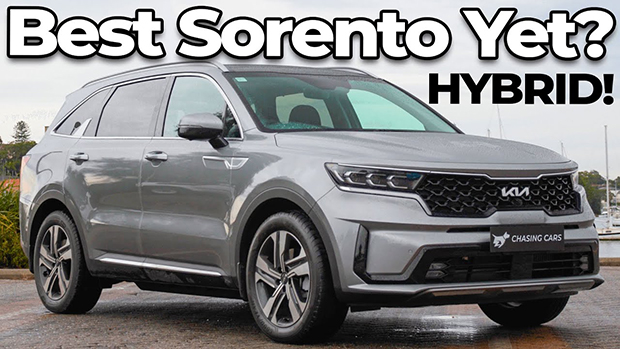
We’ve tested a host of Kia Sorento variants since the seven-seat large SUV’s Australian release in August 2020 – from likeable base model S V6 through the semi-premium GT-Line diesel – and the flagship plug-in hybrid. Each time, we’ve come away impressed by how this Korean-built SUV shrugs off the perils of daily life without feeling lifeless or staid.
The latest, fourth-generation Sorento launched in Australia initially with a sole 2.2-litre turbo diesel engine with standard AWD. Within months a front-drive 3.5-litre V6 price-leader engine joined the lineup, with the combustion engines available on each of the Sorento’s four grades. More recently, a turbo-petrol plug-in hybrid with 56km tested electric range became a $80,330 (before on-road costs) range-topper in GT-Line guise, and now, Kia has added a simpler ‘self-charging’ Sorento hybrid that is a direct rival to the petrol-electric Toyota Kluger. Unlike the AWD-only PHEV, the new Sorento Hybrid can be had with FWD ($66,750 driveaway) or AWD ($69,750 driveaway).
The latest, fourth-generation Sorento’s handsome design and endearing drive have been high points of the Mazda CX-8 and Toyota Kluger rival which, when combined with its practicality and strong value proposition make it arguably the pick of the three-row mainstream SUV segment, particularly as a well-equipped GT-Line.
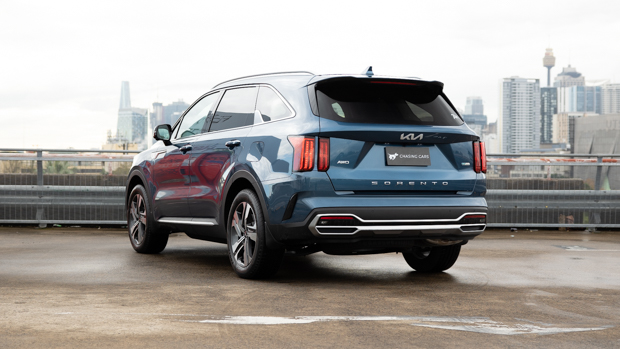
Key rivals to the new Sorento GT-Line hybrid – which claims frugal petrol use of just 5.3L/100km on the combined cycle – include the Toyota Kluger Grande hybrid ($75,700 before on-road costs), Hyundai Santa Fe Highlander AWD ($66,050) and Mazda CX-9 Azami LE ($73,881).
It’s a slightly smaller SUV than the Kluger, but its distinct price advantage compared to the Toyota, even in luxury-spec GT-Line form, should mean the Sorento hybrid is unstoppable…if it’s good to drive.
Unlike Japanese rivals Honda and Toyota, which have experimented with petrol-electric hybrid engines since 1999 and 2000 respectively, Kia is relatively new to the petrol-electric game with the eco-chic Niro crossover its only other hybrid offer in Australia. Long-running costs disputes continue to rule out a midsize Kia Sportage hybrid to take on Australia’s most popular SUV – the Toyota RAV4.
With the business case for a right-hand drive Sorento hybrid stacking up much more easily, Kia has demonstrated with this vehicle that it learns quickly – with the smoothness and refinement of this Sorento’s hybrid system not far off the buttery transitions between fuel sources in the equivalent Toyota.
Only when ascending the steep exit ramp from the basement at Chasing Cars HQ did the Sorento hybrid struggle as the 40kW electric motor failed to provide sufficient grunt to winch the seven-seater’s 1883kg kerb weight up the incline – and so the car paused and rolled back about 10cm before the 1.6-litre turbo petrol engine could kick in. This odd low-speed manoeuvre was the only clear instance where the Sorento felt less polished than a Toyota rival.
With the petrol and electric engines working together, the 169kW of power and 350Nm of torque on offer are adequate for the Sorento, with the instant boost of the electric motor (mounted between the engine and six-speed automatic transmission) helping to kick the SUV briskly up to urban speeds without troubling the petrol engine. There is decent torque left in the system above 80km/h when the power sources are working in tandem, making country-road overtaking safer.
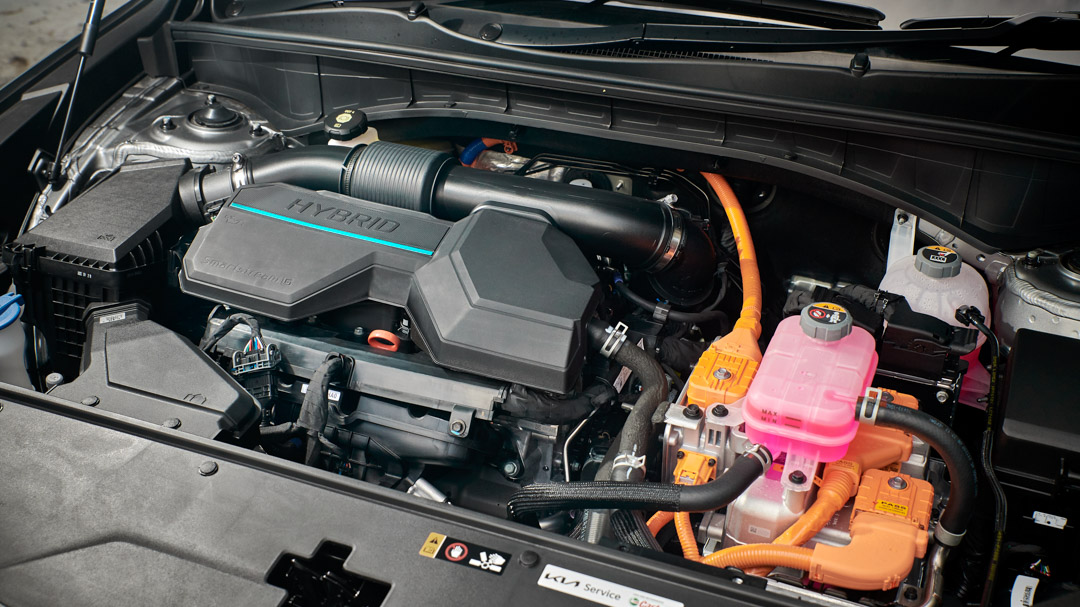
Opting for the plug-in hybrid Sorento adds another 26kW of power – and the capability to drive nearly 60km on electric power alone – but also 170kg heavier than the standard hybrid, ultimately making for evenly-matched straight-line performance – but the ‘self-charging’ hybrid is more agile in the corners.
A reasonably restrained kerb weight of 1883kg means this Sorento hybrid seems to handle near-identically to the rest of the range – and that’s a good thing. Kia’s specific Australian steering tune for the Sorento is great, with well-judged weight and sharp tip in. For a car of this type the Sorento also resists body roll impressively instilling confidence in the driver.
The hybrid’s ride is also improved over the fidgety GT-Line diesel and petrol models as it uses smaller 19-inch alloy wheels shod in 255/50-series Goodyear Eagle F1 rubber, providing more cushioning than the regular GT-Line variants that use sportier, lower-profile Continental tyres wrapped around 20-inch alloys. We have always preferred the Sorento’s ride on 19s, so combining GT-Line opulence with chunkier tyres works very well in the hybrid.
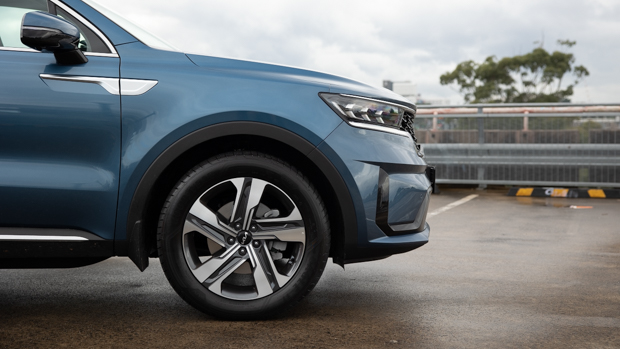
Adding to the ride comfort is an insulated cabin without the clatter of a diesel or warble of a V6. The Sorento’s 1.6 petrol turbo is also far more muzzled when it needs to make progress than the Kluger’s revvy 2.5-litre atmo petrol.
There are a raft of safety systems fitted to the Sorento including forward AEB with pedestrian, cyclist and junction detection, rear cross-traffic alert with braking, lane-keep assist, lane-trace assist, blind-spot monitoring and adaptive cruise control.
We particularly like Kia’s intuitive implementation of blind spot monitoring via a dual-camera system presented in the driver’s line of sight – within the instrument cluster.
Only the lack of a curtain airbag for the third-row hurts the Sorento’s safety score, but a centre airbag does feature and the GT-Line’s blind-spot cameras are best-in-class – we just wish more of the variants were equipped with the tech.
The Sorento’s cabin remains one of the classiest in the mainstream large SUV segment. It’s well-built and expensively trimmed, with impressive-looking quilted leather. Unfortunately, only black upholstery is available despite attractive contrast interiors being available overseas. The related Hyundai Santa Fe Highlander gives Australian buyers a range of interior colour choices, as well as black.
Aside from that, most gripes are minor. Kia has cleverly maintained a combination of physical and touch capacitive HVAC controls for the Sorento’s dual-zone climate control, there are generous door bins in the doors, sizable cup holders, a generous centre storage bin and a wireless smartphone charger.
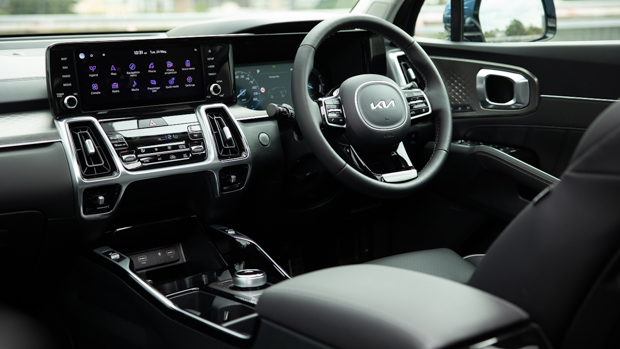
The GT-Line has a 12-way adjustable driver’s seat with the passenger scoring eight (lumbar adjustment is removed) along with three-stage seat heating and seat cooling up front. The Sorento’s seat padding is certainly firmer than a Kluger’s, but on longer drives, this factor means the Kia provides more support than the initial flatness suggests.
From the mid-tier Sport ($53,790 driveaway) grade and up, the Sorento is equipped with a 10.25-inch central touchscreen with navigation, though only the base model gets wireless Apple CarPlay and Android Auto due to an ongoing dispute with a smartphone manufacturer.
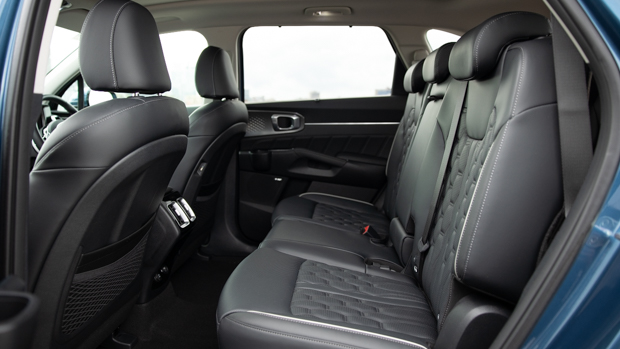
In front of the driver is a leather-appointed steering wheel with buttons to skip track, adjust volume and control the adaptive cruise control. The 12.3-inch digital driver’s display is legible and responds to the different drive modes (Eco, Smart, Normal and Sport) with different graphics, though lacks the ability to show a full-screen map as seen in the Volkswagen Tiguan Allspace.
The second row of seating is also generous and the GT-Line’s panoramic sunroof floods the cabin with sunlight and an airy feeling. The Sorento also offers plenty of headroom for taller people including me at 188cm. Materials remain soft touch on top of the doors, and there’s a fold down armrest with two-stage heating on the outboard seats.
If you want some more room in the second row the Sorento’s backrest has three positions including a very reclined one, and the squab is on sliders allowing for more room for the third row.
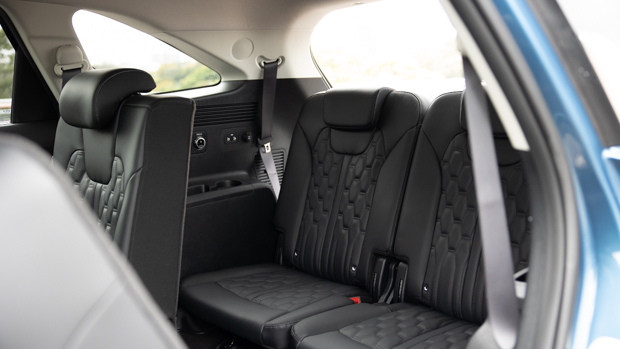
Right at the back the Sorento’s smaller dimensions than a Kluger, Palisade (or in-house Telluride) mean that it’s not the most comfortable third row for adults, however amenities like cup holders, adjustable fan speed and a pair of USB ports mean it’s the perfect place for kids.
With the third row in place luggage space falls to 178 litres for the hybrid, and with them folded space swells to 604 litres. The second row electrically folds – a nice touch – and despite hybrid gubbins Kia retains the Sorento’s full-size spare wheel located under the vehicle.
With its hybrid powertrain under the bonnet the Sorento is a refined and efficient beast, the ADR combined consumption figure is 5.3L/100km and in a real-world mix of urban, suburban and highway driving we scored 6.3L/100km which is impressive given the Sorento’s ability to lug around seven people in comfort.
Compared to the S V6 that averaged 12.3L/100km in Chasing Cars testing, the Sorento hybrid consumes nearly half the fuel while emitting fewer particulates than the 148kW 2.2-litre turbo-diesel – reducing your fuel bill and impact on the environment by a significant degree.
To put the difference to your wallet in context, it’d cost about $3800 to do 14,000km annually in a Sorento V6 at $2.20 per litre – but just $1940 to do the same distance in the hybrid, and all without having to plug it in to charge.
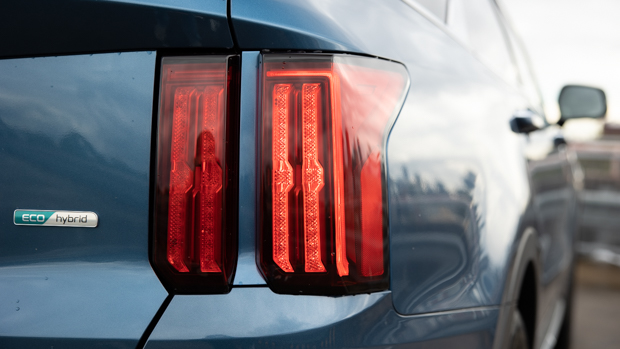
Kia stiplates servicing the Sorento every 12 months or 10,000km – matching the Mazda CX-9 (10,000km) but less convenient by distance than the Toyota Kluger Grande (15,000km).
Servicing the Sorento hybrid isn’t cheap, costing $2810 over a five-year/50,000km period. That makes the Sorento significantly more expensive than a Kluger ($1025) and a Mazda CX-9 turbo ($1910) to maintain.
Kia’s industry-leading seven year/unlimited kilometre warranty remains a strong drawcard for the brand. Mitsubishi does now offer a longer 10 year warranty though it requires the car to be serviced at a dealer, and the Outlander doesn’t offer as much interior space as the Sorento.
The Kia Sorento’s now even broader range of powertrains and hallmark dynamic prowess means that – in our eyes – it edges out the related Hyundai Santa Fe, even though the Hyundai offers more leather and colour choice, the Sorento is simply a better family vehicle.
As for how Kia’s ‘self-charging’ system compares to other series-parallel hybrid systems out there: refinement is good, but Toyota’s experience pays here with slightly smoother petrol-electric transitions and seemingly a slightly stronger electric motor providing easier momentum up inclines in car parks.
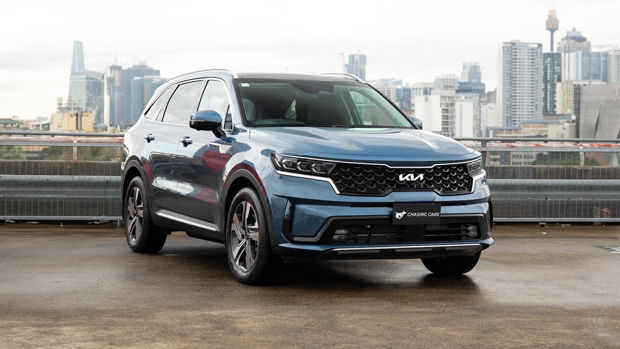
After experiencing the polish of the series-parallel hybrid and its excellent efficiency, we hope that Kia does develop a right-hand drive petrol-electric Sportage to make that midsize SUV a true rival for Australia’s favourite Toyota RAV4 hybrid.
The Sorento’s new frugal powertrain is backed up by the confident roadholding, bold cabin styling and great build quality the Sorento is known for – more choice isn’t always better, but in this case the hybrid is a winner.
Variant tested GT-LINE 7 SEAT HEV AWD
Key specs (as tested)
About Chasing cars
Chasing Cars reviews are 100% independent.
Because we are powered by Budget Direct Insurance, we don’t receive advertising or sales revenue from car manufacturers.
We’re truly independent – giving you Australia’s best car reviews.
The estimate provided does not take into account your personal circumstances but is intended to give a general indication of the cost of insurance, in order to obtain a complete quote, please visit www.budgetdirect.com.au. Estimate includes 15%^ online discount.
^Conditions Apply
Budget Direct Insurance arranged by Auto & General Services Pty Ltd ACN 003 617 909(AGS) AFSL 241 411, for and on behalf of the insurer, Auto & General Insurance Company Limited(ABN 42 111 586 353, AFSL 285 571).Because we don’t know your financial needs, we can’t advise you if this insurance will suit you. You should consider your needs and the Product Disclosure Statement before making a decision to buy insurance. Terms and conditions apply.
Indicative quote based on assumptions including postcode , 40 year old male with no offences, licence suspensions or claims in the last 5 years, a NCD Rating 1 and no younger drivers listed. White car, driven up to 10,000kms a year, unfinanced, with no modifications, factory options and/or non-standard accessories, private use only and garaged at night.
^Online Discounts Terms & Conditions
1. Discounts apply to the premium paid for a new Budget Direct Gold Comprehensive Car Insurance, Third Party Property Only or Third Party Property, Fire & Theft Insurance policy initiated online on or after 29 March 2017. Discounts do not apply to optional Roadside Assistance.
2. Discounts do not apply to any renewal offer of insurance.
3. Discounts only apply to the insurance portion of the premium. Discounts are applied before government charges, taxes, levies and fees, including instalment processing fees (as applicable). The full extent of discounts may therefore be impacted.
4. We reserve the right to change the offer without notice.